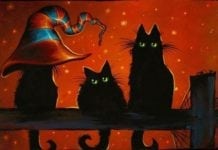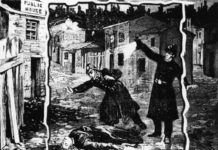Three blind mice, three blind mice,
See how they run, see how they run;
They all ran after the farmer’s wife,
Who cut off their tails with a carving knife;
Did you ever see such a thing in your life,
As three blind mice?
Some historians believe the origin of the words to ‘Three Blind Mice’ lie with the English queen Mary I (1516–58), known as Bloody Mary because of the hundreds of religious dissenters she had burned at the stake. Mary was the only child of Henry VIII and his first wife, the Spanish princess Catherine of Aragon.
Henry had initially doted upon Mary and boasted about her publicly, even breaking royal protocol by giving her the title of Princess of Wales, a prerogative usually reserved for the male firstborn, but all this changed when Catherine failed to produce a male heir, leading to events that marked a major watershed in English history
It all began when Henry attempted to dissolve his marriage to Mary’s mother, on the grounds Catherine had previously been briefly married, as a sixteen-year-old, to his elder brother Arthur, who then died only a few days later.
In his desperation for a divorce and a male heir, Henry tried to show God was on his side by citing passages from the Bible: ‘If a man shall take his brother’s wife, it is an unclean thing; he hath uncovered his brother’s nakedness and they shall remain childless’ (Leviticus 20:21).
When Pope Clement VII refused his request, Henry broke English links with the Catholic Church and declared himself head of the newly reformed Church of England. He then promptly married Anne Boleyn, who was to prove no more successful at producing a male heir than her predecessor.
As a result of the divorce, Catherine lost the title of queen and Mary was declared illegitimate, demoted from ‘princess’ to ‘lady’ and losing her position at court – earning the nickname, according to some, of the Farmer’s Wife.
Although this is more likely to be a reference to the vast estates she would own as wife of King Philip of Spain. For Thomas Cranmer, the man who eventually sanctioned Henry’s second marriage, there would be dire consequences.
Meanwhile Henry began confiscating land from the Catholics and dissolving the monasteries. During his brief reign, Henry’s son Edward VI (1537–53) took things much further and started hunting down and executing Catholic priests.
The three religious leaders supporting Edward during this time were the bishops Hugh Latimer and Nicholas Ridley and the ever-loyal Archbishop of Canterbury, Thomas Cranmer, architect of Henry VIII’s English Reformation.
Openly Catholic, Mary was seen as a real danger to newly Protestant England and the policies set in motion by these three were openly unfriendly: in effect, They all ran after the farmer’s wife.
Unluckily for them, Edward only lasted six years. When Mary I finally ascended the throne in 1553, the bitter queen immediately set about restoring the Catholic faith as the religion of England and the real blood-letting began. Over eight hundred wealthy Protestants fled the country and nearly three hundred were burned at the stake in what became known as the Marian Persecutions.
The most high-profile of these victims, later remembered as the ‘Oxford Martyrs’, were Latimer, Ridley and Cranmer, who were tortured, some stories say blinded, (the three blind mice) and then burned at the stake in central Oxford in front of hundreds of shocked spectators (she cut off their tails with a carving knife / Did you ever see such a thing in your life).
Another, less convincing theory is that three blind commoners, Joan Waste, John Aprice and an unspecified third, defied Queen Mary’s ban on reading the Bible in English and between them paid for a copy to have it read to them in public, as a result of which they were also burned at the stake.
The first written version of ‘Three Blind Mice’ was published between 1609 and 1611 by Thomas Ravenscroft (1582–1635), whose booklets Pammelia (1609), Deuteromelia (1609) and Melismata (1611) brought together a collection of street songs, ballads, poems and children’s songs that included ‘Three Blind Mice’, although with slightly different lyrics to the ones we know so well today:
Three Blinde Mice,
Three Blinde Mice,
Dame Iulian,
Dame Iulian,
The Miller and his merry olde Wife,
She scrapte her tripe licke thou the knife,
The Three Blinde Mice.
Publishing the poem only fifty years after Queen Mary’s Persecutions, Ravenscroft, a noted scholar, composer and musician, could have been recording a well-known rhyme of its day or, as some believe, may even have composed it himself.
While authorship of the rhyme is a matter of dispute, what is generally accepted is that ‘Three Blind Mice’ refers to the brutal slaying of the three bishops (‘she scraped off the entrails and licked the knife’, to translate line 6) opposed to Queen Mary’s religious reforms, one of whom had made the mistake of dissolving her mother’s marriage to King Henry VIII and reducing her status from princess to commoner.
And that meant that from the moment she became queen, Thomas Cranmer must have known his days were numbered. – Albert Jack
Albert Jack AUDIOBOOKS available for download here

Pop Goes the Weasel – Nursery Rhyme History







































